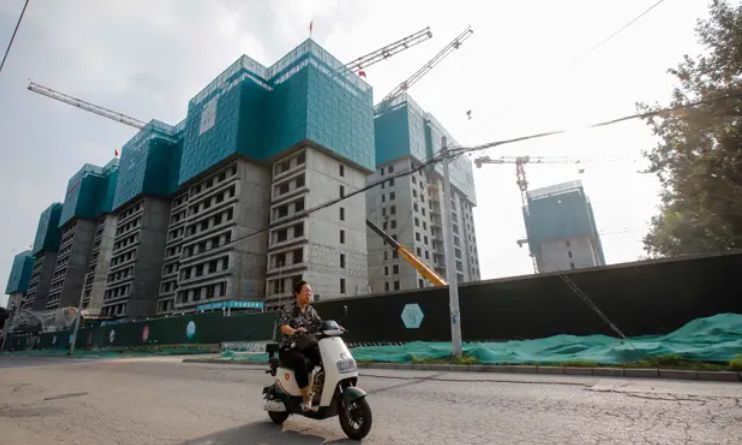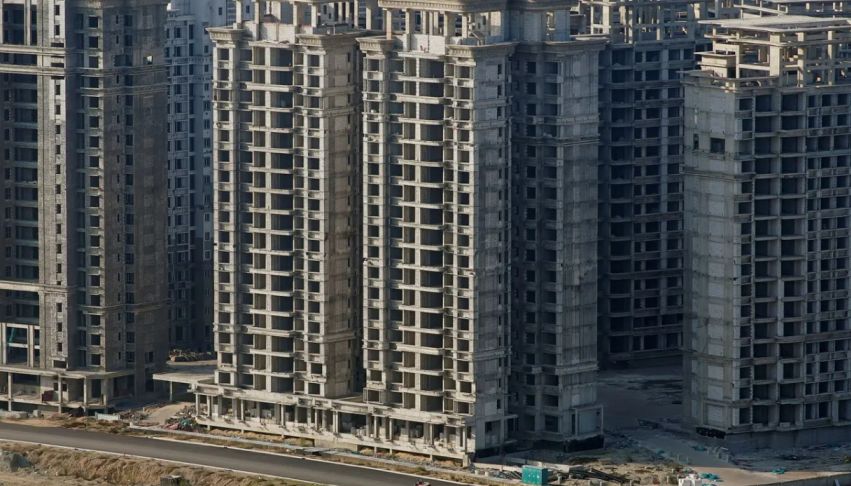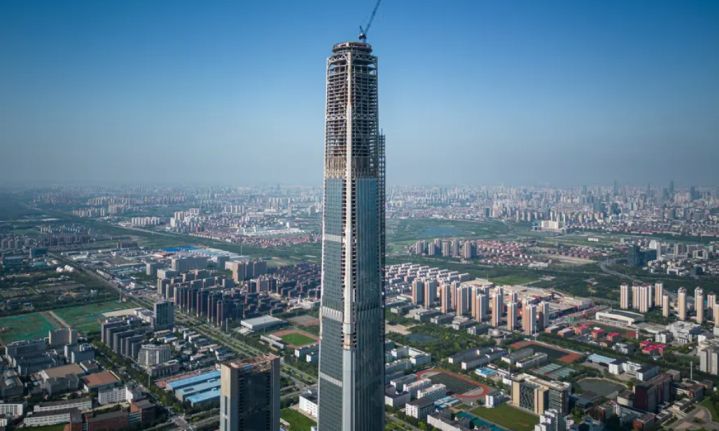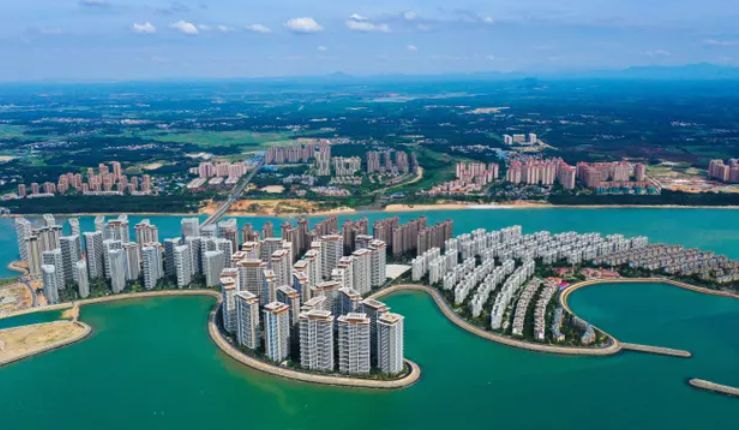By Eric Vandenbroeck and co-workers
Global
implications of China's real estate crunch
The Chinese real estate sector is teetering. The largest private
Chinese developer has defaulted on its external bonds. Most developers are
struggling to refinance their domestic bonds. Home prices have gone down for
the last 11 months. New construction is down 45 percent. The most acute stress
can be traced back to developers who raised large sums by preselling
yet-to-be-built apartments. Some, however, failed to set aside reserves to
guarantee the completion of these units, and households that took out mortgages
to buy these homes have threatened to stop paying.
China’s real estate crisis poses financial risks, but it is
ultimately a crisis of economic growth. Since the development and construction
of new property is estimated to drive over a quarter of the country’s current
economic activity, it is not difficult to see how a temporary downturn in the
property market could become a prolonged economic slump.

A woman rides a motorbike
next to a construction site in Beijing this month.
The country’s state-backed financial system can still take large losses
and thus avoid a financial meltdown. One state-backed institution can put money
into another state institution, limiting the chance that losses on lending to a
failed property firm will lead to the collapse of its creditors and trigger a
cascade of defaults. The Chinese government can ask state-backed developers to
complete building projects abandoned by private developers, providing financial
help through the state policy banks. Pervasive government intervention isn’t
the best way to run an economy over time. Still, the presence of institutions with
deep pockets can prevent the destabilizing withdrawal of all financing to the
property market.
As a result, China likely will not suffer a crisis that recalls the
U.S. Great Recession of 2008. But that doesn’t mean the Chinese economy is in
the clear. A new growth engine won’t automatically replace the boost the
property sector traditionally provided. If China elects to goose growth by
increasing exports—as it has done in the past—that could have serious
implications for countries around the world struggling to find their economic
footing after the shocks of the COVID-19 pandemic and Russia’s
invasion of Ukraine.
The ant, not the
grasshopper
China’s banks, trusts, and other financial institutions have lent huge
sums to China’s property developers, to households looking to buy apartments,
and to local governments building public infrastructure even as
China’s big policy banks financed construction projects around
the world as part of its Belt and Road
Initiative. China’s financial system could do both kinds of
lending without borrowing large sums from the rest of the world, thanks to its
enormously high domestic savings rate, which has averaged about 45 percent of
its GDP over the last 20 years. By contrast, most large economies save about 25
percent of their GDP; before the pandemic, the high-saving Asian economies
other than China generally saved about 30 percent of their GDP. Only
oil-exporting economies generate comparable levels of national savings to
China, and they usually do so for only a brief period after a large and
unexpected rise in the price of oil.
Saving is often considered a virtue, and the absence of significant
external debt gives China more options for managing the current property slump.
External credit, especially external credit to banks, is often withdrawn
quickly during a market downturn. Domestically raised funds, in contrast, are
generally stuck inside China.

But too much saving helped create China’s current financial
difficulties, as it fostered an economic environment where China’s rapid growth
effectively required increasing domestic debt. To understand why it helps to
remember that the counterpart of high savings is low domestic consumption. As a
result, China’s rapid growth over the last 20 years has rested on
either the ballast of exports or periodic bursts of investment.
Before the 2008 global financial crisis, China’s internal debt-to-GDP ratio
was stable, as China could reign in its financial sector while stunning export
growth propelled China’s economy and industrial development. Export-led
growth minimized debt risks inside China but was destabilizing to the rest of
the global economy. It led to job losses in the manufacturing-intensive parts
of the European and U.S. economies; the United States was able to overcome
the drag on demand from large external deficits only through an increase in
household borrowing that proved to be globally destabilizing. Put simply, it
was one of the factors that helped spark the 2008 recession.
After the global financial crisis, China
maintained its rapid growth while its trade surplus shrank through
extraordinary investment in property and infrastructure. Mobilizing such high
investment required higher domestic borrowing as well. In the ten years
following the global financial crisis, China’s internal debt-to-GDP ratio rose
from around 150 percent to over 250 percent of GDP. In essence, the debts of
households, local governments, real estate developers, and state firms have all
increased faster than their incomes. Ultimately, that is a risky dynamic.
That said, China’s central government debt has been stable: the
country’s debt is less than 20 percent of its GDP—far below that of the world’s
other major economies. China’s central state unambiguously has a large role in
China’s economy, but that is because it backs most large Chinese banks and many
investment funds. The Chinese government doesn’t collect a lot of tax, nor does
it spend a lot on social benefits: China has not created a national system of
unemployment insurance, does not offer high-quality universal health care, and
limits the public services available to Chinese workers who move from rural
areas to more prosperous coastal cities.

An unfinished skyscraper in
Tianjin, China
The result is an unusual mix of financial strengths and weaknesses. The
central government in Beijing owns some of China’s most profitable companies,
and it backs the healthiest part of China’s financial system, namely the big
national banks. It has little direct debt. Local governments, however, are
carrying substantial debt and have a weaker revenue base. They are also
indirectly responsible for the many state firms that have been created to
finance local infrastructure projects, and they back many of the weaker locally
owned banks.
The big property developers, meanwhile, carry staggering debt. The
market borrowing of the largest private property developer, Evergrande, is
around $100 billion. If all its promised apartments and unpaid bills are
counted, the company owes an estimated $300 billion. Its peers have only slightly
smaller balance sheets. China’s total debt isn’t a problem for an economy that
saves as much as China does—the real problem is that the wrong parts of the
economy are carrying most of the debt and will have difficulty repaying it.
Still, China will likely manage the immediate financial risk that its
property downturn has created. Some of the weaker property developers may not
pay all their debt on time and in full. But China’s central government can
protect important institutions lent to the big property developers. Beijing can
also help local governments that will need to rescue local banks to support
locally essential firms.
China’s central government doesn’t want to cover all losses, however.
Too much help would fail to teach a lesson to those who lent to the most poorly
managed property developers, potentially leading to a new round of risky
behavior. At the same time, the central government cannot allow all the big
property developers to fail simultaneously. It also cannot allow losses on past
investment projects to stop the flow of new infrastructure financing because
China’s economy would seize up from unpaid bills and stalled building projects.
Unemployed urban workers and angry buyers of unbuilt apartments would threaten
social and political stability. A restructuring of the developers' debts is
inevitable—but that restructuring must be combined with steps to help the
financial system bear the associated losses and ensure the flow of credit to
the economy doesn’t stop completely.
A new model
In addition to avoiding a severe financial crisis, the Chinese
government must find a new growth engine to replace the property sector's
ballast. Specifically, household consumption needs a jolt. COVID-19 lockdowns have
taken a toll, and falling property
prices could lead worried households to cut back on spending when the overall
economy needs more consumer demand.
This means China must shift to a new model for delivering stimulus by
providing help directly to households. China’s persistently low consumption
reflects the insecurities created by limited social benefits, high-income
inequality, and the burden low-income households carry because of a tax system
that raises the bulk of its revenue from consumption taxes and poorly designed
payroll taxes. In the long term, China needs a more robust national system of
social insurance—in particular, more spending on public health and a better
system of unemployment insurance—that is financed by higher progressive income
taxes collected by the central government.
In the short run, China needs to shore up its existing system for
providing social services and income support by transferring more revenue to
local governments. China has historically kept central government borrowing by
shifting the financial burden to local governments. But this approach now risks
the country’s financial stability. Local government revenues are under pressure
from the property downturn, as they have relied extensively on land sales to
property developers to help cover their budgets. The path to a healthier
economy—driven more by household consumption and less by state-guided investment—currently
runs through an increase in the central government’s China, however, has been
reluctant to move away from its existing model.

Ocean Flower Island off the coast of Hainan. Evergrande has reportedly
been ordered to demolish 39 buildings at the project
The country’s top leadership views direct support for household
spending as unproductive, and the finance ministry has consistently resisted
running large central government budget deficits. The Chinese government’s
recent announcements suggest it wants to try to restart growth by authorizing
more local investment in infrastructure and displacing imports with Chinese
technology. But the high-wire act required to keep China’s economy moving
without a more stable base of increased domestic consumption will only get more
precarious over time.
Global implications
China’s trade partners have a large stake in the outcome of the
internal Chinese debate. For most of the global economy, how China grows
matters at least as much as how fast it grows. China relied on exports, rather
than a rebound in household consumption, to drive its recovery from the
outbreak of COVID-19 in Wuhan in 2019.
With a shift in global demand toward goods putting upward pressure on prices
everywhere, countries around the world have tolerated (if not always warmly
welcomed) the increased supply out of China. China’s trade surplus was expected
to fall naturally as COVID-19-related disruptions eased globally and in China.
That hasn’t happened. Instead, the latest trade data show that China’s
external surplus is rising on the back of weakness in China’s imports. Over the
summer, the world economy was lucky, as China’s slowdown reduced commodity
demand when the global economy struggled to adapt to a reduction in supply. But
this doesn’t mean that the global economy can make up for a sustained shortfall
in China’s own ability to generate demand for the industrial goods that its
economy can now produce in large quantities.
Back in 2009, China’s economy could pivot away from exports toward domestic
real estate investment to mitigate the global fallout from the U.S. housing
crisis because China’s financial system was strong enough to support this
shift. Plus, China needed more housing and modern infrastructure. Today, China
could not reverse that pivot with a large move away from real estate and back
to exports without significant disruption, partly because its share of the
global economy has roughly tripled in the years since the global financial
crisis. The scale of the lost domestic activity from real estate that would
need to be made up through a shift in global demand toward Chinese goods is
just too big, and China’s trading partners themselves are often struggling with
their debt challenges.
China can manage a permanent downshift in real estate
investment by taking steps to sustain and strengthen household demand and find
new ways to help the industrial sectors rely on excessive property investment
retool to meet internal consumer demand. Above all, Chinese government
officials need to accept this complicated truth: rising internal debt and the
end of a period of unusually high investment means that China’s historic growth
surge is most likely a thing of the past.
For updates click hompage here